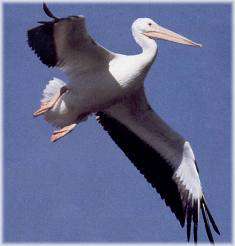Grand Lake Migratory Fowl
category : Birdwatching
 The American White Pelican - Pelicans have lived in our world for over 35,000,000 years and have changed very little in that period of time - a truly pre-historic creature. We are fortunate in the Grand Lake area that the American White Pelican spends time here during both spring and fall migration. They have adapted well to the many reservoirs in Oklahoma, enjoying the abundance of gizzard shad and other non-gamefish, as well as the many quiet secluded areas where they may rest undistrubed by people.
The American White Pelican - Pelicans have lived in our world for over 35,000,000 years and have changed very little in that period of time - a truly pre-historic creature. We are fortunate in the Grand Lake area that the American White Pelican spends time here during both spring and fall migration. They have adapted well to the many reservoirs in Oklahoma, enjoying the abundance of gizzard shad and other non-gamefish, as well as the many quiet secluded areas where they may rest undistrubed by people.During Fall migration, the birds arrive in our area in mid to late September, staying until November. Here they rest and feed before flying on to their winter home along the gulf of Mexico. The Pelicans are usually sighted on the northern end of the lake in the Twin Bridges area near Wyandotte and gradually move down the lake as more of the flock arrives.
As with all wild creatures their whereabouts can be hard to predict as they might be found in the shallows anywhere on the lake. However, here are a few favorite spots they can be found:
- On either side of Sailboat Bridge on US 59 North of Grove
- In Elk River area near Number 10 Bridge on Hwy 10 northeast of Grove
- In Carey Bay on west side of Grove
- In Honey Creek at the south edge of Grove
- In Horse Creek near Bernice
- In the Twin Bridges area near Wyandotte
- In the Wolf Creek area at City Park off 16th Strteet in Grove
- In the Grand River below the Pensacola Dam at the south end of the lake
- Shallow end of Drowning Creek in a south end arm of the lake
White Pelicans are protected under the Migratory Bird Act.
Bald Eagles - Oklahoma is an important wintering area for the bald eagle and GRDA is fortunate to be able to provide habitat to support their presence. In early December, the first of many bald eagles to spend part of their winter in the Grand Lake and Lake Hudson areas was spotted below Pensacola Dam and they are also finding their way to the tailrace waters below Robert S. Kerr Dam.
Most of the migrating eagles in northeastern Oklahoma come from Canada and the Great Lake states. Their numbers should peak in January through February before they head north in mid-March.
The best GRDA viewing areas vary from year to year. However, the waters below Kerr and Pensacola dams are always a good bet. The eagles like to perch in tall trees below the dams until they are ready to feed. The best time to view the eagles is in the early morning, especially when GRDA is generating at the dams.
Migratory Fowl - In 1994, GRDA began an innovative seeding project along the shores of Grand Lake. By dropping the lake to an elevation of 741 feet (above sea level), thousands of acres of mudflat areas were exposed. GRDA then used a cropduster plane to seed these mudflat areas with 10,000 pounds of Japanese millet. For a month following the seeding, the lake was kept at the lower level to allow the seed to germinate and grow. GRDA then raised the lake back to its normal elevation allowing acres and acres of new vegetation to serve as a food source for the various species of migratory waterfowl that pass through the Grand Lake area in the fall and winter. And below the surface, the rich vegetation serves as protective cover for the young fish that are hatched out each spring. The project began in 1994 and was expected to last five years.
The millet seeding project benefits several different species. Biologists sighted Canda Geese, Mallards, Blue-winged Teal, Green-winged Teal, Gadwalls, Widgeons, Pintails, Redheads, Wood Ducks, Cormorants, Pelicans, Mergansers, Grebes, Ruddy Ducks, Goldeneyes, Lesser Scaups, Ringnecks, Canvasbacks, Buffleheads, Shovelers, White-fronted Geese, Loons and other species around the lake when the last survey was done a few years ago. The cooling and settling ponds on the grounds of GRDA's Coal-Fired Complex are also a haven for Canada Geese.
Address: Grand Lake Area
Phone: 918-256-7537
Come visit us in , Oklahoma